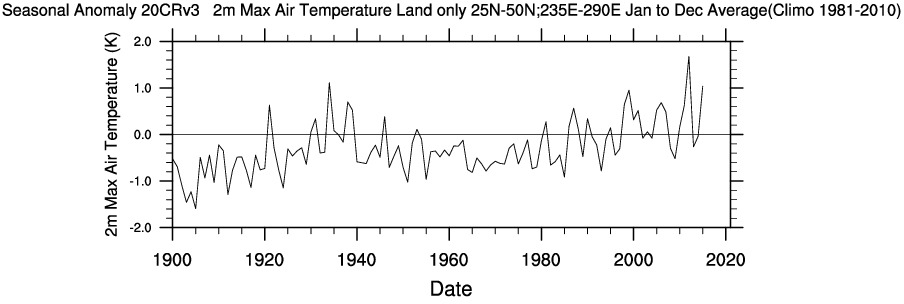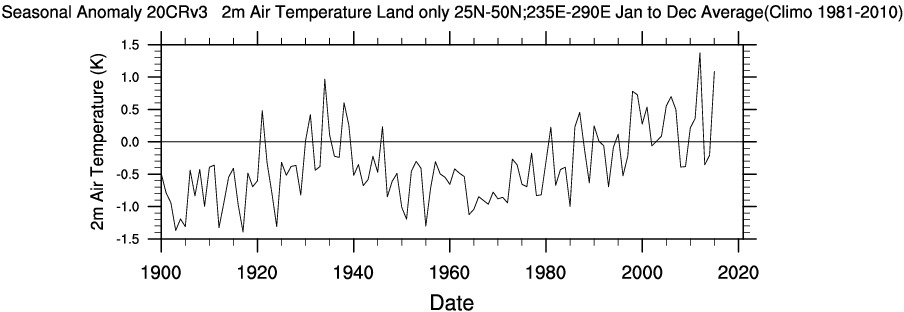Regular readers will no doubt have noticed by now that here at the Great White Con we are publishing a series of reviews of Steven E. Koonin‘s new book “Unsettled”? Today we move on to the topic of Land-Surface Air Temperature (LSAT for short). Here is an extract from the very first page of the book:
Yes, it’s true that the globe is warming, and that humans are exerting a warming influence upon it. But beyond that—to paraphrase the classic movie The Princess Bride: “I do not think ‘The Science’ says what you think it says.”
For example, both the research literature and government reports that summarize and assess the state of climate science say clearly that heat waves in the US are now no more common than they were in 1900, and that the warmest temperatures in the US have not risen in the past fifty years. When I tell people this, most are incredulous. Some gasp. And some get downright hostile.
Here once again is an extract from page 23 of the Kindle edition of Steve’s book:
The [IPCC] assessment reports literally define The Science for non-experts. Given the intensive authoring and review processes, any reader would naturally expect that their assessments and summaries of the research literature are complete, objective, and transparent—the “gold standard.” In my experience, the reports largely do meet that expectation, and so much of the detail in the first part of this book, the science story, is drawn from them.
First of all let me remind Steve that the United States does not constitute the entirety of our planet. In particular the Arctic is warming a lot faster than mid latitudes in general and the US in particular. Using WRIT once again to produce our own time series, we can compare and contrast longer term temperature records between the Continental United States and the Arctic (including both land and ocean above the Arctic circle):



Also note that for some reason Steve makes no mention of US “coolest temperatures” and/or “cold waves” since 1900. I don’t know about you, but the top graph certainly suggest to me that “the warmest temperatures in the US have risen in the past fifty years”.
Let’s see how Steve explains himself. For that we have to wait until Chapter 5, catchily entitled “Hyping the Heat”. Therein no mention is made of recent temperature increases across the Arctic, but we are able to read in the introductory paragraphs that:
We can all agree the globe has gotten warmer over the past several decades. Here’s another summary statement from the IPCC’s AR5:
[S]ince about 1950 it is very likely that the numbers of cold days and nights have decreased and the numbers of warm days and nights have increased . . . there is medium confidence that globally the length and frequency of warm spells, including heat waves, has increased since the middle of the 20th century. (IPCC. AR5 WGI Section 2.6.1.)
Then there is a long discussion about what Steve apparently perceives to be shortcomings in the “The US government’s most recent assessment report, the 2017 Climate Science Special Report (CSSR)”. Steve is apparently well qualified in physics, so presumably he is able to comprehend these equations?
- US ≠ Global
- CSSR ≠ AR5
For those of you less familiar with the arcane language of mathematics and physics that translates to “the climate of the continental United States is not identical to Arctic climate or typical of the climate of Planet Earth as a whole” and hence “US Governmental climate reports are not necessarily typical of ‘Intergovernmental’ climate assessments”.
Next let’s check what Steve’s “gold standard for The Science” has to say on this topic. According to section 2.6.1 of the Intergovernmental Panel on Climate Change’s fifth Assessment Report, as cited by Steve:
A large amount of evidence continues to support the conclusion that most global land areas analysed have experienced significant warming of both maximum and minimum temperature extremes since about 1950 (Donat et al., 2013c). Changes in the occurrence of cold and warm days (based on daily maximum temperatures) are generally less marked (Figure 2.32):

warm days (TX90p) (Box 2.4, Table 1). Trends were calculated only for grid boxes that had at least 40 years of data during this period and where data ended no earlier than 2003.
Grey areas indicate incomplete or missing data. Black plus signs (+) indicate grid boxes where trends are significant (i.e., a trend of zero lies outside the 90% confidence interval).
The data source for trend maps is HadEX2 (Donat et al., 2013c) updated to include the latest version of the European Climate Assessment data set (Klok and Tank, 2009). Beside
each map are the near-global time series of annual anomalies of these indices with respect to 1961–1990 for three global indices data sets: HadEX2 (red); HadGHCND (Caesar et al., 2006; blue) and updated to 2010 and GHCNDEX (Donat et al., 2013a; green). Global averages are only calculated using grid boxes where all three data sets have at least 90%
of data over the time period. Trends are significant (i.e., a trend of zero lies outside the 90% confidence interval) for all the global indices shown.
To paraphrase The Princess Bride once again: “I do not think ‘The Science’ says what Steven E. Koonin says it says in ‘Unsettled’”.
Unsettling, is it not?
The very first page…wow. It looks like the entire book is based on this ridiculous conflation. I get embarrassed just reading it. It may be in the future nobody will admit being descendents of these people. That is, if these people allow us to continue our civilization.
Thanks, Jim, for buying and then analyzing this “piece of work.”
Apart from not mentioning sea ice whilst getting all hot and bothered about the alleged absence of US heat waves and the sluggish Greenland Ice Sheet melt Steve also asserts on page 1 that:
Then it all goes south from there!
The net effect IS minimal when compared with actual growth rates expected this century.
According to whom?
Sadly you missed Koonin’s point, which was a focus on clear misrepresentation in the CSSR.
Hi James,
My apologies for the “brief hiatus” before approval of your comment.
It may well be that Prof. Koonin’s focus is (in part?) as you describe.
Perhaps that (partially?) explains the “cherry picking” exercise he undertakes in “Unsettled”?
He admits it is all about detectability and he can’t take those words back!
Prof. Koonin can’t take back his “The IPCC assessment reports literally define ‘The Science’ for non-experts.” either.
Moving beyond “hurricanes” perhaps he should have used the recommended IPCC terminology in his introduction? Which is the less US centric “tropical cyclones”?
Or if he really meant what the IPCC calls “Atlantic hurricanes” perhaps he should have mentioned this extract from the North America section of the AR5 WG1 report somewhere in his book?
Climate fanatics like Hunt cannot possibly be reasoned with since they are of a cult or a religion based on faith (and power).
Welcome William,
Do you have any evidence to offer to back up your assertion?
I’m a little confused about the first 3 time-series.
I’m not sure which are for US or Arctic.
Also, can you explain the terms of art:
– Seasonal Anomaly 20CRv3
– 25N-50N;235E-290E
– Climo 1981-2010
I think I understand that the graphs are for:
1. 2m Max Air Temperature Land only
2. 2m Air Temperature Land only
3. 2m Air Temperature
– Seasonal Anomaly 20CRv3 – 2m Max Air Temperature – Land only – 25N-50N;235E-290E – Jan to Dec Average – (Climo 1981-2010)
– Seasonal Anomaly 20CRv3 2m Air Temperature Land only 25N-50N;235E-290E Jan to Dec Average (Climo 1981-2010)
– Seasonal Anomaly 20CRv3 2m Air Temperature 67N-90N;0E-360E Jan to Dec Average (Climo 1981-2010)
In brief:
“25N-50N;235E-290E Land Only” is an approximation to “The continental US”
“67N-90N;0E-360E” is an approximation to “The Arctic”
“20CRv3” = “Twentieth Century Reanalysis version 3”:
https://psl.noaa.gov/data/gridded/data.20thC_ReanV3.html
The anomaly graphs are with respect to “Climo 1981-2010”, the average of the respective variables for the respective regions over the 30 year period 1981-2010.
Does that help at all?
Yes that helps. But I’m not sure I know what an anomaly graph is. It seems like you are figuring the average LSAT over a 30 year period and then charting how much the LSAT deviates from that average. And since the degree of deviation is increasing, that indicates that we are having more warm days, and/or less cold days, and/or higher extremes.
In the quote by Koonin, he claims that the warmest LSAT in the US has not risen over the last 50 years. I haven’t read the book, but I’m not sure I understand what is he claiming? That there have been no new all time highs in the last 50 years?
I guess I’m starting my climate education and have a bunch of such questions.
That’s near enough re “anomalies”. However it’s not me doing “the figuring”. I’m merely using the tools helpfully provided by NOAA to generate time series graphs of their data. If so desired WRIT allows you to graph the data from other providers as well, including NASA, the UK Met Office, the European Centre for Medium-Range Weather Forecasts and the Japan Meteorological Agency amongst others.
I’m not sure that Prof. Koonin knows what he’s claiming! He states in the intro to “Unsettled” that “The warmest temperatures in the US have not risen in the past fifty years” but doesn’t explain precisely what he means by “warmest temperatures”. Of course “the US” is only a small part of “the World”, but sticking with the US in chapter 5 he writes:
Perhaps he should have written “frequency of record daily high temperatures” in his introduction?